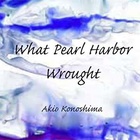Two hours later -- the road's ascent seemed endless -- the bus finally moved into a small valley. To one side, narrow-gauged railway cars, which looked like toys when compared to the freight cars at home, stood intermixed with flat-bottom gondolas, some stacked with lumber, others empty. In a far corner lay twisted rails, other debris, and the stubbed remains of a steel radio transmission tower.
However, no signs of the war could be seen as the bus moved through the main street of a town. Small shops, like those in Tokyo's suburbs, lined both sides of the street. But unlike Tokyo, the air was clean. The vermilion trimmings of storefronts with shiny black and orange finishes, the show windows, the brown and red roof tiling, even the unpainted wood of the buildings, looked newly washed. Instead of gutters, water seemingly clean enough to drink flowed in stone flues along each side of the street. Here and there rice bowls, chopsticks, dishes, pots and pans were drying on trays at the water's edge.
On his left, through the openings between shops and low buildings, he caught glimpses of a swiftly-flowing river, its white wake highlighted by the water's blue and light green. Beyond the river, dark, tree-covered mountains rose steeply. Jo pressed his face against the bus window for a glance at the mountain peaks.
Small wonder that his father was such a nature lover, Jo thought as the bus slowed to a stop. Then to his delight, he saw a white wooden sign with black military lettering (also the only reminder he could see of the Occupation) which read "Hachiman," both in Roman letters and Kanji.
"Erashai-mase," a man in his mid-twenties, about Jo's age, said as he bowed when Jo stepped off of the bus. It was Isamu, the cousin Jo had sent the letter to so the relatives knew he was coming.
"Hajima mashite," Jo said, returning the man's bow. Isamu, thin and a bit taller than Jo, had his black hair neatly combed back, giving emphasis to a sharp nose and pointed features. He had on a worn, though neatly pressed, gray suit and a woven tie, making Jo suddenly conscious of his crumpled, olive-drab uniform.
Before Jo had a chance to study his cousin's face -- Jo didn't see any family resemblance -- two women and a man in kimono, and a second man in a western-style suit moved forward. Through the bowing and exchange of greetings, Jo didn't catch any of the names, but each was a cousin, aunt or uncle. Meeting five at once left him more confused than acquainted.
Isamu, who had taken a day off from his job with the county government, and Miyoko, a cousin, took Jo to an inn just a few doors away, where Jo could freshen up, have lunch and then go over the schedule that had been planned for him. The others, bowing their apologies, left to return to work. Except for Isamu, all of them obviously were older than Jo, and Jo felt a tinge of embarrassment -- maybe he should have been bowing to them first rather than the other way around.
At the inn, Jo and Isamu were comfortably seated by a hibachi in a balcony-like room that extended over the river. Miyoko, whose husband owned the inn, had gone to order the lunch.
Leaning back and smiling, Isamu explained how relieved he was that Jo spoke some Japanese. The letter that Jo had sent ahead of his visit had been written by a Japanese where Jo worked. Isamu wasn't sure if Jo spoke any Japanese at all, since he had heard that many Nisei did not speak the language, and nobody in town could really speak that much English.
Studied it at the Army language school, Jo said, though he still had problems reading and writing Japanese.
By custom, Jo was to spend the first night at the hon-ke -- the ancestral home, Isamu said as he went over a schedule that had been planned for Jo. He said it was the house Jo's father was born in. Isamu, his wife and their two children now lived there with Jo's oldest uncle, the family patriarch. The home was in a village about 12 miles further into the mountains, and after lunch, Isamu would take Jo there on his mo-ped. Jo would spend the second night at the home of another uncle, the one closest to Jo's father's age. On Saturday, Isamu said, all of Jo's relatives -- Jo's father was the youngest of seven children -- would gather back in Hachiman to meet him.
As Isamu talked, Jo could hardly keep from looking out over the scenery. With the shoji pulled aside, a panorama of the mountains and stream was spread before them. Some trees along the banks of the river -- the Nagara-gawa -- were showing yellow and red, though the dark green of pine and cypress trees remained dominant.
Above the river, about two-thirds of the way up what seemed the highest peak of the nearby mountains, Jo could see a castle, its eaves turned skyward, its white paint and gray granite gleaming in the sun.
Isamu said the castle, built in the mid-1600s, was a favorite landmark for people of the area. With what could have been a painful smile, he said that during the war it was a focal point in the flight pattern for the American B-29 bombers. The planes flew in from over Nagoya, then would turn right above the castle towards targets further to the northeast. The bombers, he said, followed the same route through the mountains that typhoons did.
Miyoko, when she returned, had dozens of anecdotes to tell about Jo's father when the father was young. Jo's father was able to catch the elusive ayu -- a trout-like fish -- with his bare hands in the mountain streams and was always in the mountains, hunting or fishing, she said. He never seemed to study, but did well in school and was one of the few from the village to leave to go to high school, she said. He was always a dreamer, as well, she said: used to play games about traveling the world. No one was really surprised when he ended up living overseas.
She reminded Jo of his own oldest sister -- flat nose, the fold of her eyelids, a round face.
© 2010 Akio Konoshima




